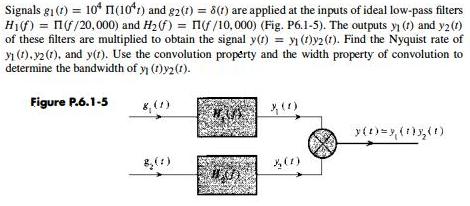Question
Signals g1 (1) = 10* n(10*1) and g2(1) = 5(1) are applied at the inputs of ideal low-pass filters H1f) = nG/20,000) and H2(f)

Signals g1 (1) = 10* n(10*1) and g2(1) = 5(1) are applied at the inputs of ideal low-pass filters H1f) = nG/20,000) and H2(f) = nf/10,000) (Fig. P6.1-5). The outputs yy (1) and y2(0) of these filters are multiplied to obtain the signal y(1) = y (t)y2(1). Find the Nyquist rate of yi (1). y2(1), and y(r). Use the convolution property and the width property of convolution to determine the bandwidth of yy (1)y2(1). Figure P.6.1-5 ,(1) (1)
Step by Step Solution
3.29 Rating (158 Votes )
There are 3 Steps involved in it
Step: 1
Given 10 80 92 t 1 9 10 cat H f T F20600 Hz 1 TC 10000 We know that 77 J t Sins ...
Get Instant Access to Expert-Tailored Solutions
See step-by-step solutions with expert insights and AI powered tools for academic success
Step: 2

Step: 3

Ace Your Homework with AI
Get the answers you need in no time with our AI-driven, step-by-step assistance
Get StartedRecommended Textbook for
Accounting
Authors: Jonathan E. Duchac, James M. Reeve, Carl S. Warren
23rd Edition
978-0324662962
Students also viewed these Electrical Engineering questions
Question
Answered: 1 week ago
Question
Answered: 1 week ago
Question
Answered: 1 week ago
Question
Answered: 1 week ago
Question
Answered: 1 week ago
Question
Answered: 1 week ago
Question
Answered: 1 week ago
Question
Answered: 1 week ago
Question
Answered: 1 week ago
Question
Answered: 1 week ago
Question
Answered: 1 week ago
Question
Answered: 1 week ago
Question
Answered: 1 week ago
Question
Answered: 1 week ago
Question
Answered: 1 week ago
Question
Answered: 1 week ago
Question
Answered: 1 week ago
Question
Answered: 1 week ago
Question
Answered: 1 week ago
Question
Answered: 1 week ago
Question
Answered: 1 week ago
View Answer in SolutionInn App



